Particle Swarm-Based Federated Learning Approach for Early Detection of Forest Fires
Abstract
1. Introduction
1.1. Stages of Forest Fire Management
- Disaster mitigation
- Disaster preparedness
- Disaster response
- Disaster recovery
- Cost of data collection: Network communication and storage costs for collecting and managing large amounts of original data on the server are high.
- Network Latency: The time taken for communication between the client and server in ML is more, the response time is increased and which causes delays in response to the disaster.
- Low computation capability: The processors in mobile devices do not have sufficient computing capabilities for ML.
- Security threat: Collecting or storing private data increases the likelihood of data breaches.
1.2. Key Contributions
- We propose a methodology that addresses the latency in communication. Our method introduces a new paradigm of effective holistic integration of FL and PSO, bringing the widely recognized advantages of swarm intelligence to distributed learning applications.
- The experimental evaluations show that the proposed methodology outperforms the conventional FL approaches. The proposed PSO-enabled FL has an accuracy improvement.
- The findings from the extensive experimental analysis demonstrate that the proposed PSO-enabled FL outperforms better than the benchmark techniques in terms of achieving higher testing accuracy.
1.3. Paper Organization
2. Background and Related Work
2.1. Traditional Machine Learning Approaches
2.2. Federated Learning
- 1.
- The server creates a model based on the data available.
- 2.
- Sends a copy of the model to all the clients and the model is trained on each client based on the local data.
- 3.
- The models that are trained at clients are sent back to the server.
- 4.
- The models sent from each client are aggregated on the server side using aggregation algorithms.
- 5.
- The server sends the new updates to the client and this process repeats till the optimal model is created.
2.3. Particle Swarm Optimization
2.4. Natural Disaster Analysis
2.5. Related Work
3. Research Methodology and Research Questions
- How can PSO-enabled FL help in detecting forest fires?
- Why only PSO is used to optimize FL and why not other bio-inspired algorithms?
- How better is the proposed framework performing than other traditional approaches?
4. Proposed Methodology
| Algorithm 1 Federated Average algorithm |
|
| Algorithm 2 PSO-enabled FL algorithm |
|
5. Experiments and Results
5.1. Experimental Setup
5.2. Dataset Collection and Preparation
5.2.1. Dataset Pre-Processing
- (1)
- by identifying fire flames or
- (2)
- by detecting smoke from fire flames.
- Fire (1): Pictures of forest and mountain fires with flames and/or smoke.
- No-Fire (0): Images of the forest and mountains are taken from various angles but without any fire or smoke.
5.2.2. Dataset Partitioning
5.3. CNN
5.3.1. Pooling
5.3.2. Activation Functions
5.3.3. Optimizer
5.4. Experimental Results
5.4.1. Performance of the Proposed Approach
5.4.2. Performance Comparison with Other Models
5.5. Analysis and Discussion
6. Conclusions and Future Directions
Author Contributions
Funding
Institutional Review Board Statement
Informed Consent Statement
Data Availability Statement
Conflicts of Interest
Abbreviations
| FL | Federated Learning |
| ML | Machine Learning |
| IoT | Internet of Things |
| LBFFPS | Learning-based forest fire prediction system |
| CNN | Convolutional Neural Network |
| RF | Random Forest |
| PSO | Particle Swarm Optimization |
| DL | Deep Learning |
| NN | Neural Networks |
| UAV | Unmanned Aerial Vehicles |
| FedAvg | Federated Averaging Algorithm |
| FedSGD | Federated Stochastic Gradient Descent |
| FedPer | Federated Personalization Approach |
| FedMA | Federated Matched Averaging |
References
- Our World in Data. Research and Data to Make Progress against the World’s Largest Problems. 2021. Available online: https://ourworldindata.org/ (accessed on 20 November 2022).
- Kumar, M. 10 Natural Disasters That Have Taken Place Around The World in 2022. 2020. Available online: https://www.holidify.com/pages/natural-disasters-in-the-world-in-2020-4836.html (accessed on 20 November 2022).
- He, B.J.; Wang, J.; Zhu, J.; Qi, J. Beating the urban heat: Situation, background, impacts and the way forward in China. Renew. Sustain. Energy Rev. 2022, 161, 112350. [Google Scholar] [CrossRef]
- Bhattacharya, S.; Victor, N.; Chengoden, R.; Ramalingam, M.; Selvi, G.C.; Maddikunta, P.K.R.; Donta, P.K.; Dustdar, S.; Jhaveri, R.H.; Gadekallu, T.R. Blockchain for Internet of Underwater Things: State-of-the-Art, Applications, Challenges, and Future Directions. Sustainability 2022, 14, 15659. [Google Scholar] [CrossRef]
- Pandya, S.; Gadekallu, T.R.; Maddikunta, P.K.R.; Sharma, R. A Study of the Impacts of Air Pollution on the Agricultural Community and Yield Crops (Indian Context). Sustainability 2022, 14, 13098. [Google Scholar] [CrossRef]
- Li, Y. A Survey on Communication Networks in Emergency Warning Systems. Sci. Comput. 2011, 100, 314. [Google Scholar]
- Alamgir, M.; Campbell, M.; Sloan, S.; Engert, J.; Word, J.; Laurance, W. Emerging challenges for sustainable development and forest conservation in Sarawak, Borneo. PLoS ONE 2020, 15, e0229614. [Google Scholar] [CrossRef]
- Su, L.; Zhao, J.; Wang, W. Distributed Adaptive Fuzzy Modeling for Industrial Gas-Electricity Networks with Multi-Operation Modes. IEEE Trans. Ind. Inform. 2022, 1–12. [Google Scholar] [CrossRef]
- Hemmati, R.; Saboori, H.; Jirdehi, M.A. Stochastic planning and scheduling of energy storage systems for congestion management in electric power systems including renewable energy resources. Energy 2017, 133, 380–387. [Google Scholar] [CrossRef]
- Elliott, R.T.; Fernández-Blanco, R.; Kozdras, K.; Kaplan, J.; Lockyear, B.; Zyskowski, J.; Kirschen, D.S. Sharing Energy Storage Between Transmission and Distribution. IEEE Trans. Power Syst. 2019, 34, 152–162. [Google Scholar] [CrossRef]
- Zhang, J.; Li, W.; Han, N.; Kan, J. Forest fire detection system based on ZigBee wireless sensor network. Front. For. China 2008, 3, 369–374. [Google Scholar] [CrossRef]
- Seydi, S.T.; Saeidi, V.; Kalantar, B.; Ueda, N.; Halin, A.A. Fire-Net: A deep learning framework for active forest fire detection. J. Sensors 2022, 2022, 8044390. [Google Scholar] [CrossRef]
- Fadlullah, Z.M.; Kato, N. On Smart IoT Remote Sensing over Integrated Terrestrial-Aerial-Space Networks: An Asynchronous Federated Learning Approach. IEEE Netw. 2021, 35, 129–135. [Google Scholar] [CrossRef]
- Aljumah, A. IoT-inspired Framework for Real-time Prediction of Forest Fire. Int. J. Comput. Commun. Control 2022, 17, 1–18. [Google Scholar] [CrossRef]
- Ananthi, J.; Sengottaiyan, N.; Anbukaruppusamy, S.; Upreti, K.; Dubey, A.K. Forest fire prediction using IoT and deep learning. Int. J. Adv. Technol. Eng. Explor. 2022, 9, 246. [Google Scholar]
- Singh, M.; Huang, Z. Analysis of Forest Fire Dynamics, Distribution and Main Drivers in the Atlantic Forest. Sustainability 2022, 14, 992. [Google Scholar] [CrossRef]
- Qian, J.; Lin, H. A Forest Fire Identification System Based on Weighted Fusion Algorithm. Forests 2022, 13, 1301. [Google Scholar] [CrossRef]
- Sun, W.; Bocchini, P.; Davison, B.D. Applications of artificial intelligence for disaster management. Nat. Hazards 2020, 103, 2631–2689. [Google Scholar] [CrossRef]
- Kuglitsch, M.M.; Pelivan, I.; Ceola, S.; Menon, M.; Xoplaki, E. Facilitating adoption of AI in natural disaster management through collaboration. Nat. Commun. 2022, 13, 1579. [Google Scholar] [CrossRef]
- Dampage, U.; Bandaranayake, L.; Wanasinghe, R.; Kottahachchi, K.; Jayasanka, B. Forest fire detection system using wireless sensor networks and machine learning. Sci. Rep. 2022, 12, 46. [Google Scholar] [CrossRef]
- Wahyono; Harjoko, A.; Dharmawan, A.; Adhinata, F.D.; Kosala, G.; Jo, K.H. Real-Time Forest Fire Detection Framework Based on Artificial Intelligence Using Color Probability Model and Motion Feature Analysis. Fire 2022, 5, 23. [Google Scholar] [CrossRef]
- Khan, A.; Hassan, B.; Khan, S.; Ahmed, R.; Abuassba, A. DeepFire: A Novel Dataset and Deep Transfer Learning Benchmark for Forest Fire Detection. Mob. Inf. Syst. 2022, 2022, 5358359. [Google Scholar] [CrossRef]
- Yang, S.; Lupascu, M.; Meel, K.S. Predicting forest fire using remote sensing data and machine learning. In Proceedings of the AAAI Conference on Artificial Intelligence, Virtual, 2–9 February 2021; Volume 35, pp. 14983–14990. [Google Scholar]
- Li, Z.; Jiang, H.; Mei, Q.; Li, Z. Forest Fire Recognition Based on Lightweight Convolutional Neural Network. J. Internet Technol. 2022, 23, 1147–1154. [Google Scholar]
- Zhao, D.; Li, N.; Zare, E.; Wang, J.; Triantafilis, J. Mapping cation exchange capacity using a quasi-3d joint inversion of EM38 and EM31 data. Soil Tillage Res. 2020, 200, 104618. [Google Scholar] [CrossRef]
- Zhao, D.; Wang, J.; Zhao, X.; Triantafilis, J. Clay content mapping and uncertainty estimation using weighted model averaging. CATENA 2022, 209, 105791. [Google Scholar] [CrossRef]
- Mammen, P.M. Federated learning: Opportunities and challenges. arXiv 2021, arXiv:2101.05428. [Google Scholar]
- Kandati, D.R.; Gadekallu, T.R. Genetic Clustered Federated Learning for COVID-19 Detection. Electronics 2022, 11, 2714. [Google Scholar] [CrossRef]
- Konečnỳ, J.; McMahan, H.B.; Yu, F.X.; Richtárik, P.; Suresh, A.T.; Bacon, D. Federated learning: Strategies for improving communication efficiency. arXiv 2016, arXiv:1610.05492. [Google Scholar]
- McMahan, B.; Moore, E.; Ramage, D.; Hampson, S.; Y Arcas, B.A. Communication-efficient learning of deep networks from decentralized data. arXiv 2017, arXiv:1602.05629. [Google Scholar]
- Konečnỳ, J.; McMahan, B.; Ramage, D. Federated optimization: Distributed optimization beyond the datacenter. arXiv 2015, arXiv:1511.03575. [Google Scholar]
- Alazab, M.; RM, S.P.; Parimala, M.; Maddikunta, P.K.R.; Gadekallu, T.R.; Pham, Q.V. Federated Learning for Cybersecurity: Concepts, Challenges, and Future Directions. IEEE Trans. Ind. Inform. 2021, 18, 3501–3509. [Google Scholar] [CrossRef]
- Mothukuri, V.; Parizi, R.M.; Pouriyeh, S.; Huang, Y.; Dehghantanha, A.; Srivastava, G. A survey on security and privacy of federated learning. Future Gener. Comput. Syst. 2021, 115, 619–640. [Google Scholar] [CrossRef]
- Arivazhagan, M.G.; Aggarwal, V.; Singh, A.K.; Choudhary, S. Federated learning with personalization layers. arXiv 2019, arXiv:1912.00818. [Google Scholar]
- Wang, H.; Yurochkin, M.; Sun, Y.; Papailiopoulos, D.; Khazaeni, Y. Federated learning with matched averaging. arXiv 2020, arXiv:2002.06440. [Google Scholar]
- Taheri, R.; Shojafar, M.; Alazab, M.; Tafazolli, R. FED-IIoT: A robust federated malware detection architecture in industrial IoT. IEEE Trans. Ind. Inform. 2020, 17, 8442–8452. [Google Scholar] [CrossRef]
- Agrawal, S.; Sarkar, S.; Aouedi, O.; Yenduri, G.; Piamrat, K.; Alazab, M.; Bhattacharya, S.; Maddikunta, P.K.R.; Gadekallu, T.R. Federated learning for intrusion detection system: Concepts, challenges and future directions. Comput. Commun. 2022, 195, 346–361. [Google Scholar] [CrossRef]
- Yang, Z.; Gang, A.; Bajwa, W.U. Adversary-resilient distributed and decentralized statistical inference and machine learning: An overview of recent advances under the Byzantine threat model. IEEE Signal Process. Mag. 2020, 37, 146–159. [Google Scholar] [CrossRef]
- Agrawal, S.; Chowdhuri, A.; Sarkar, S.; Selvanambi, R.; Gadekallu, T.R. Temporal weighted averaging for asynchronous federated intrusion detection systems. Comput. Intell. Neurosci. 2021, 2021, 5844728. [Google Scholar] [CrossRef]
- Wang, D.; Tan, D.; Liu, L. Particle swarm optimization algorithm: An overview. Soft Comput. 2018, 22, 387–408. [Google Scholar] [CrossRef]
- Połap, D.; Woźniak, M. Meta-heuristic as manager in federated learning approaches for image processing purposes. Appl. Soft Comput. 2021, 113, 107872. [Google Scholar] [CrossRef]
- Barnes, B.; Dunn, S.; Wilkinson, S. Natural hazards, disaster management and simulation: A bibliometric analysis of keyword searches. Nat. Hazards 2019, 97, 813–840. [Google Scholar] [CrossRef]
- Gadekallu, T.R.; Pham, Q.V.; Huynh-The, T.; Bhattacharya, S.; Maddikunta, P.K.R.; Liyanage, M. Federated learning for big data: A survey on opportunities, applications, and future directions. arXiv 2021, arXiv:2110.04160. [Google Scholar]
- Said, N.; Ahmad, K.; Riegler, M.; Pogorelov, K.; Hassan, L.; Ahmad, N.; Conci, N. Natural disasters detection in social media and satellite imagery: A survey. Multimed. Tools Appl. 2019, 78, 31267–31302. [Google Scholar] [CrossRef]
- Cui, P.; Peng, J.; Shi, P.; Tang, H.; Ouyang, C.; Zou, Q.; Liu, L.; Li, C.; Lei, Y. Scientific challenges of research on natural hazards and disaster risk. Geogr. Sustain. 2021, 2, 216–223. [Google Scholar] [CrossRef]
- Jing, S.; Xiao, C. Federated Learning via Over-the-Air Computation with Statistical Channel State Information. IEEE Trans. Wirel. Commun. 2022, 21, 9351–9365. [Google Scholar] [CrossRef]
- Fan, X.; Wang, Y.; Huo, Y.; Tian, Z. Joint optimization of communications and federated learning over the air. IEEE Trans. Wirel. Commun. 2021, 21, 2798–2803. [Google Scholar] [CrossRef]
- Yang, K.; Jiang, T.; Shi, Y.; Ding, Z. Federated learning based on over-the-air computation. In Proceedings of the ICC 2019—2019 IEEE International Conference on Communications (ICC), Shanghai, China, 20–24 May 2019; pp. 1–6. [Google Scholar]
- Eberhart, R.; Kennedy, J. A new optimizer using particle swarm theory. In Proceedings of the Sixth International Symposium on Micro Machine and Human Science, MHS’95, Nagoya, Japan, 4–6 October 1995; pp. 39–43. [Google Scholar]
- Poli, R.; Kennedy, J.; Blackwell, T. Particle swarm optimization. Swarm Intell. 2007, 1, 33–57. [Google Scholar] [CrossRef]
- Serizawa, T.; Fujita, H. Optimization of convolutional neural network using the linearly decreasing weight particle swarm optimization. arXiv 2020, arXiv:2001.05670. [Google Scholar]
- Junior, F.E.F.; Yen, G.G. Particle swarm optimization of deep neural networks architectures for image classification. Swarm Evol. Comput. 2019, 49, 62–74. [Google Scholar] [CrossRef]
- Syulistyo, A.R.; Purnomo, D.M.J.; Rachmadi, M.F.; Wibowo, A. Particle swarm optimization (PSO) for training optimization on convolutional neural network (CNN). J. Ilmu Komput. Dan Inf. 2016, 9, 52–58. [Google Scholar] [CrossRef]
- Qolomany, B.; Ahmad, K.; Al-Fuqaha, A.; Qadir, J. Particle swarm optimized federated learning for industrial IoT and smart city services. In Proceedings of the GLOBECOM 2020—2020 IEEE Global Communications Conference, Taipei, Taiwan, 7–11 December 2020; pp. 1–6. [Google Scholar]
- Park, S.; Suh, Y.; Lee, J. FedPSO: Federated learning using particle swarm optimization to reduce communication costs. Sensors 2021, 21, 600. [Google Scholar] [CrossRef]
- Yarradoddi, S.; Gadekallu, T.R. Federated Learning Role in Big Data, Jot Services and Applications Security, Privacy and Trust in Jot A Survey. In Trust, Security and Privacy for Big Data; CRC Press: Boca Raton, FL, USA, 2022; pp. 28–49. [Google Scholar]
- Kathen, M.J.T.; Johnson, P.; Flores, I.J.; Reina, D.G.E. AquaFeL-PSO: A Monitoring System for Water Resources using Autonomous Surface Vehicles based on Multimodal PSO and Federated Learning. arXiv 2022, arXiv:2211.15217. [Google Scholar]
- Torra, V.; Galván, E.; Navarro-Arribas, G. PSO + FL = PAASO: Particle swarm optimization + federated learning = privacy-aware agent swarm optimization. Int. J. Inf. Secur. 2022, 21, 1–11. [Google Scholar] [CrossRef]
- Li, Y.; Chen, Y.; Zhu, K.; Bai, C.; Zhang, J. An Effective Federated Learning Verification Strategy and Its Applications for Fault Diagnosis in Industrial IoT Systems. IEEE Internet Things J. 2022, 9, 16835–16849. [Google Scholar] [CrossRef]
- Hu, Y.; Zhang, Y.; Gao, X.; Gong, D.; Song, X.; Guo, Y.; Wang, J. A federated feature selection algorithm based on particle swarm optimization under privacy protection. Knowl.-Based Syst. 2022, 260, 110122. [Google Scholar] [CrossRef]
- Agrawal, S.; Sarkar, S.; Alazab, M.; Maddikunta, P.K.R.; Gadekallu, T.R.; Pham, Q.V. Genetic CFL: Hyperparameter optimization in clustered federated learning. Comput. Intell. Neurosci. 2021, 2021, 7156420. [Google Scholar] [CrossRef]
- Sousa, M.J.; Moutinho, A.; Almeida, M. Wildfire detection using transfer learning on augmented datasets. Expert Syst. Appl. 2020, 142, 112975. [Google Scholar] [CrossRef]
- Govil, K.; Welch, M.L.; Ball, J.T.; Pennypacker, C.R. Preliminary Results from a Wildfire Detection System Using Deep Learning on Remote Camera Images. Remote Sens. 2020, 12, 166. [Google Scholar] [CrossRef]
- Sun, X.; Sun, L.; Huang, Y. Forest fire smoke recognition based on convolutional neural network. J. For. Res. 2021, 32, 1921–1927. [Google Scholar] [CrossRef]
- Tang, Y.; Feng, H.; Chen, J.; Chen, Y. ForestResNet: A deep learning algorithm for forest image classification. In Journal of Physics: Conference Series; IOP Publishing: Changsha, China, 2021; p. 012053. [Google Scholar]
- Schroeder, W.; Oliva, P.; Giglio, L.; Csiszar, I.A. The New VIIRS 375 m active fire detection data product: Algorithm description and initial assessment. Remote Sens. Environ. 2014, 143, 85–96. [Google Scholar] [CrossRef]
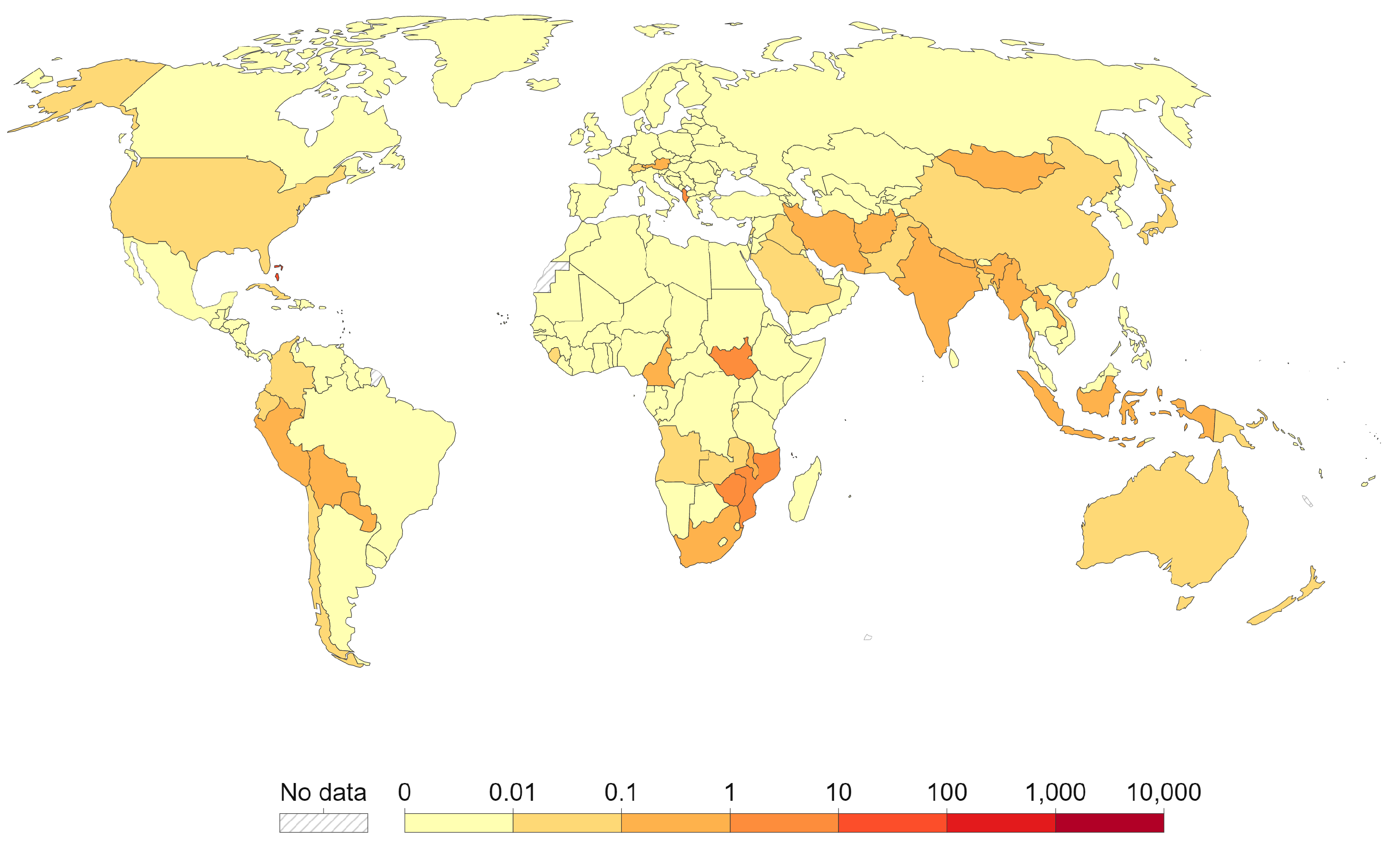
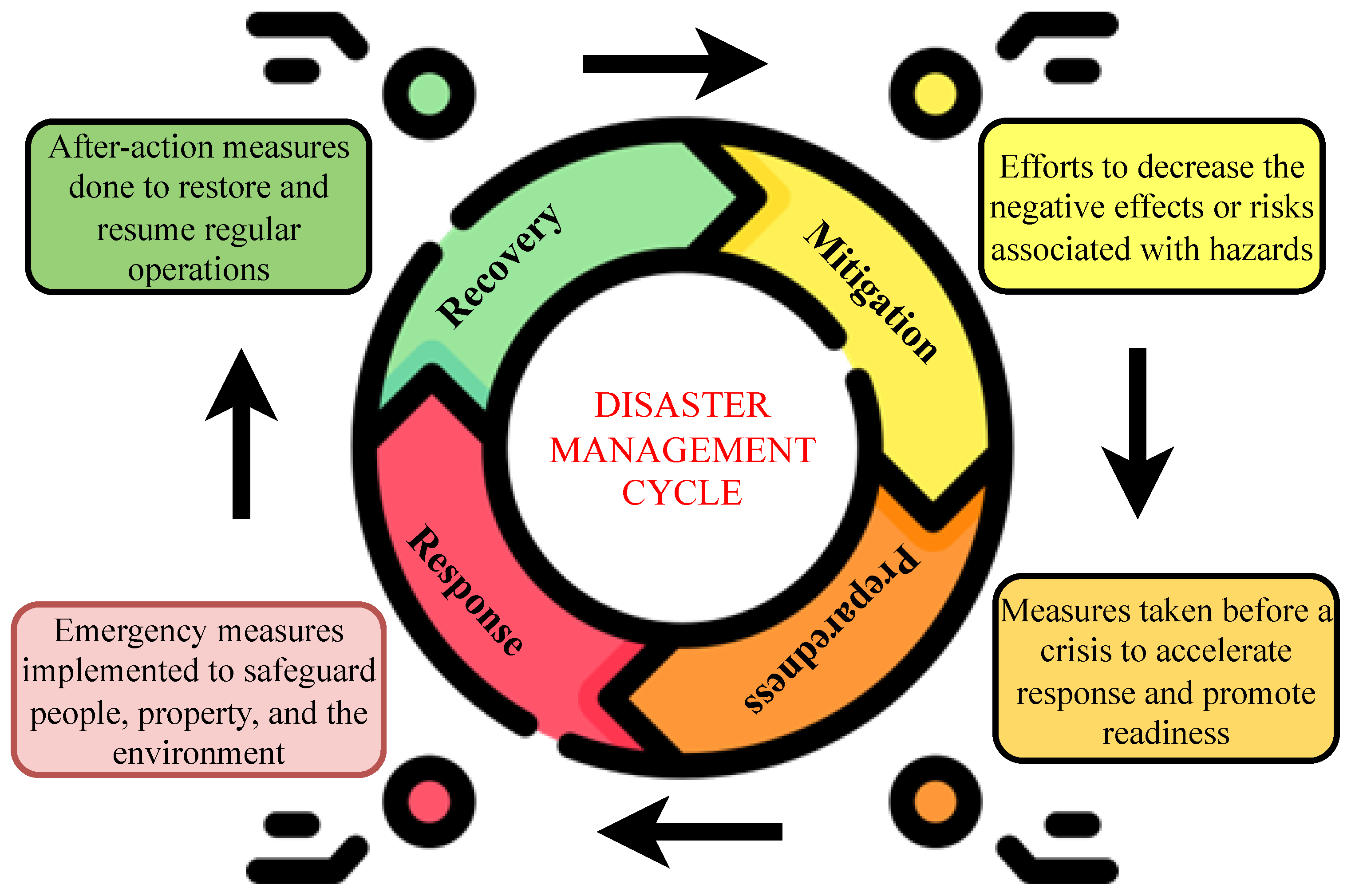

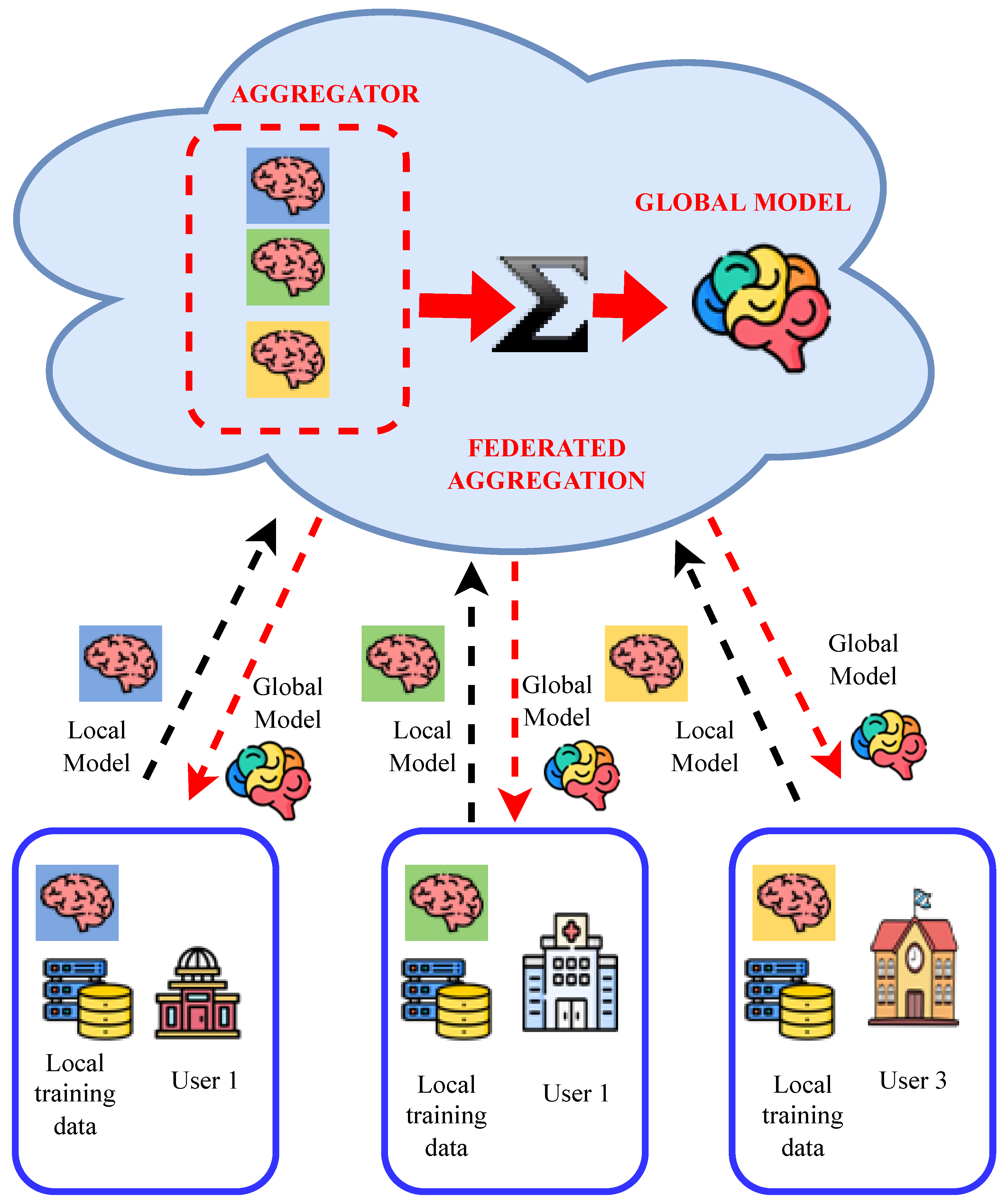
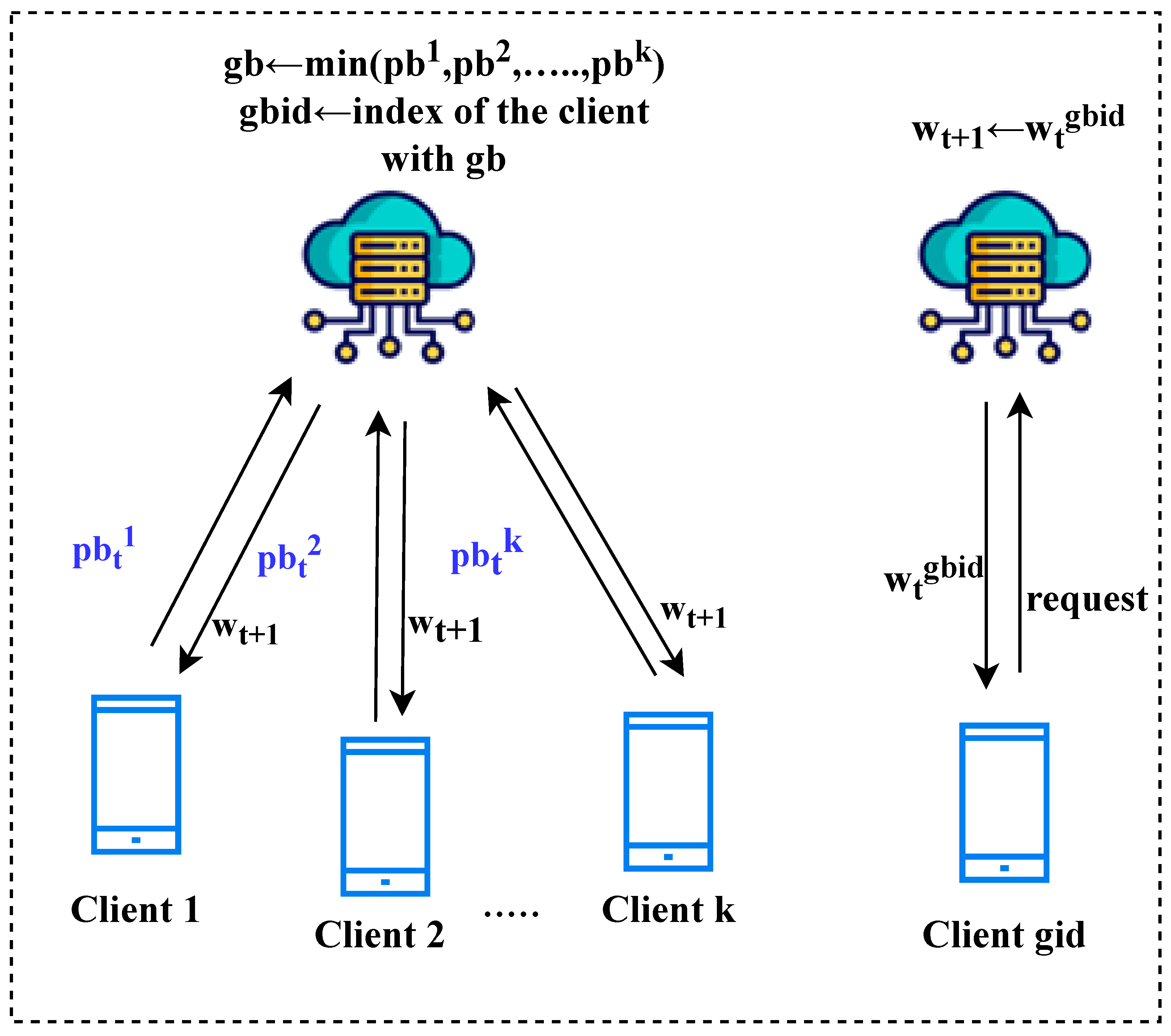
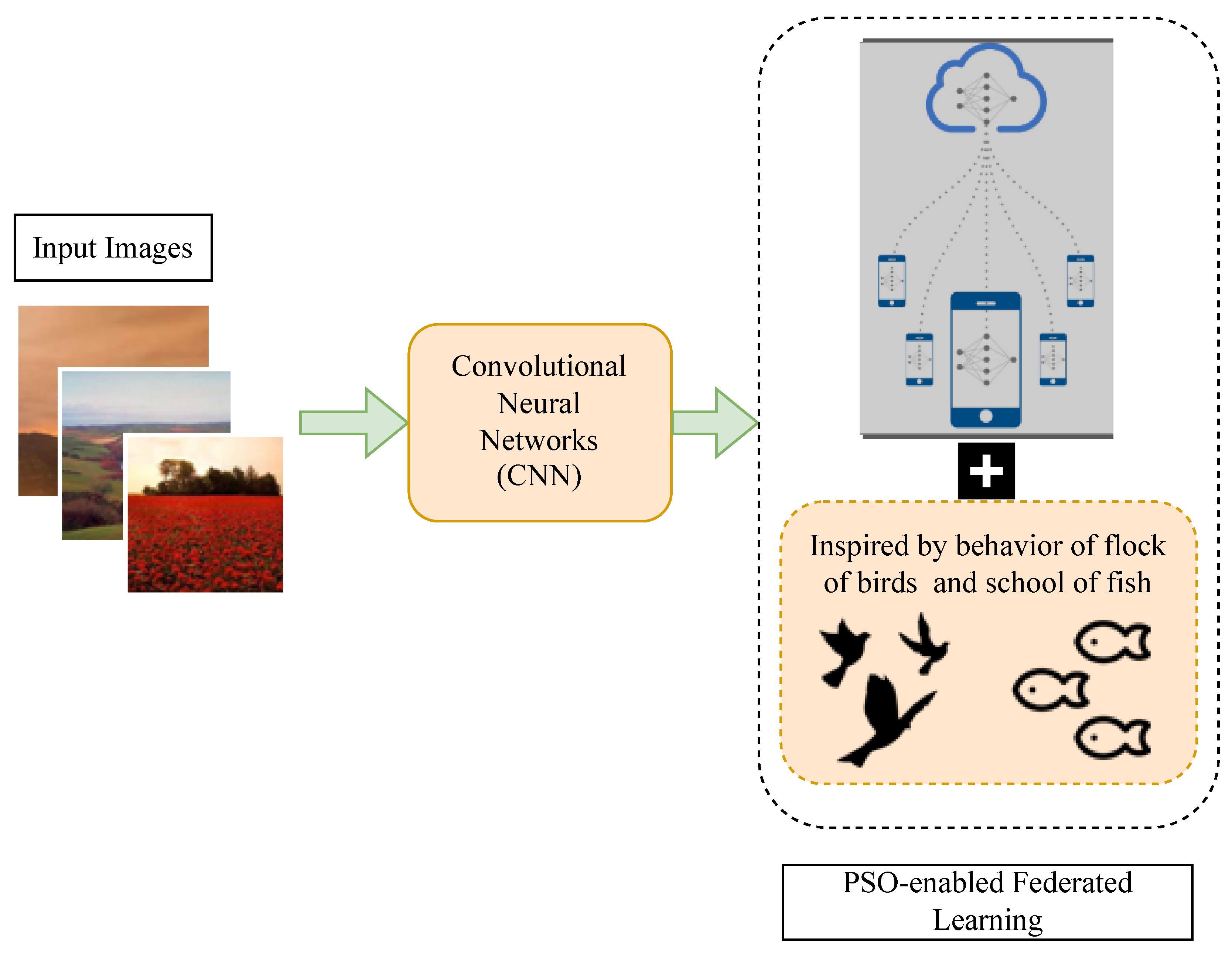

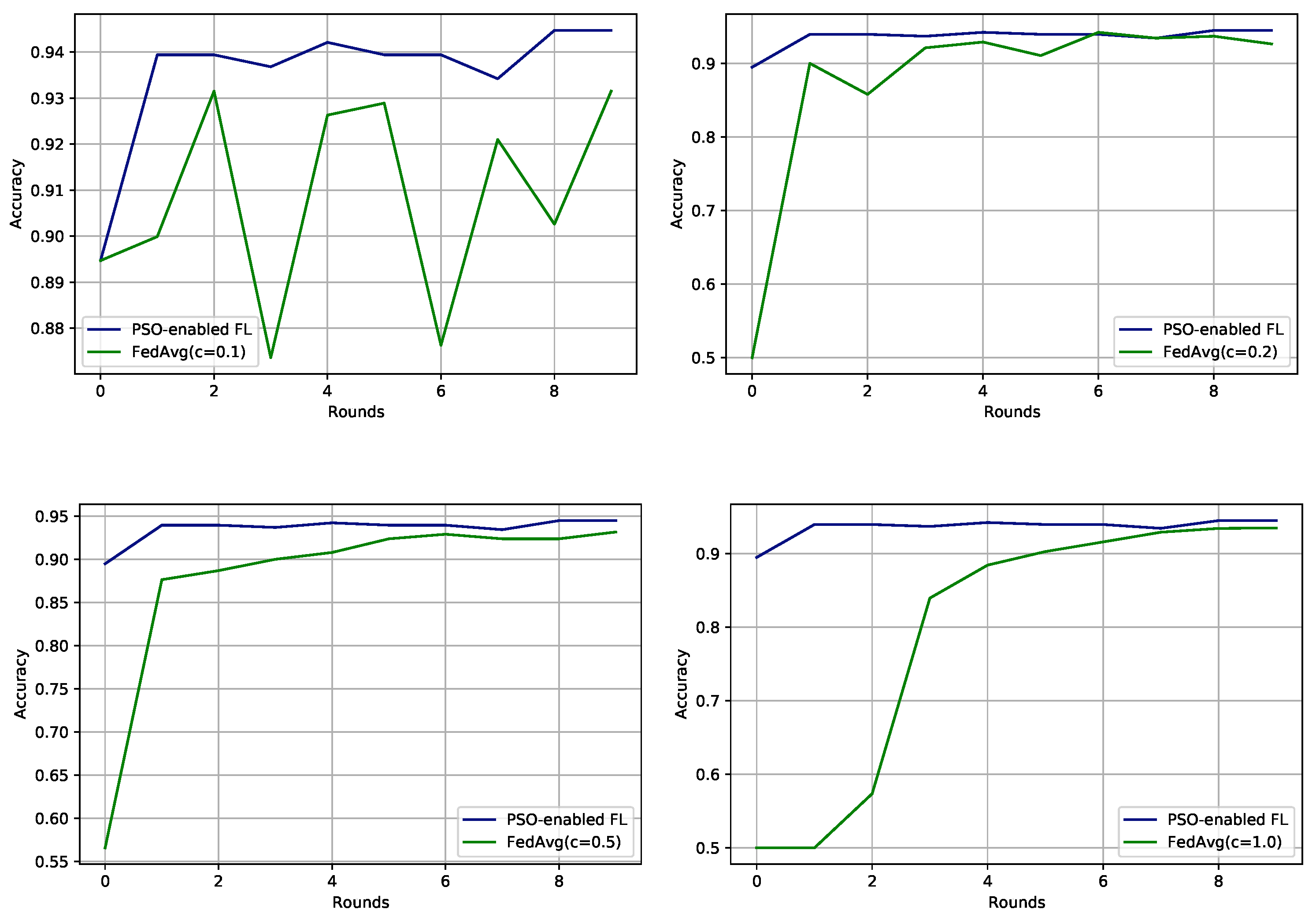
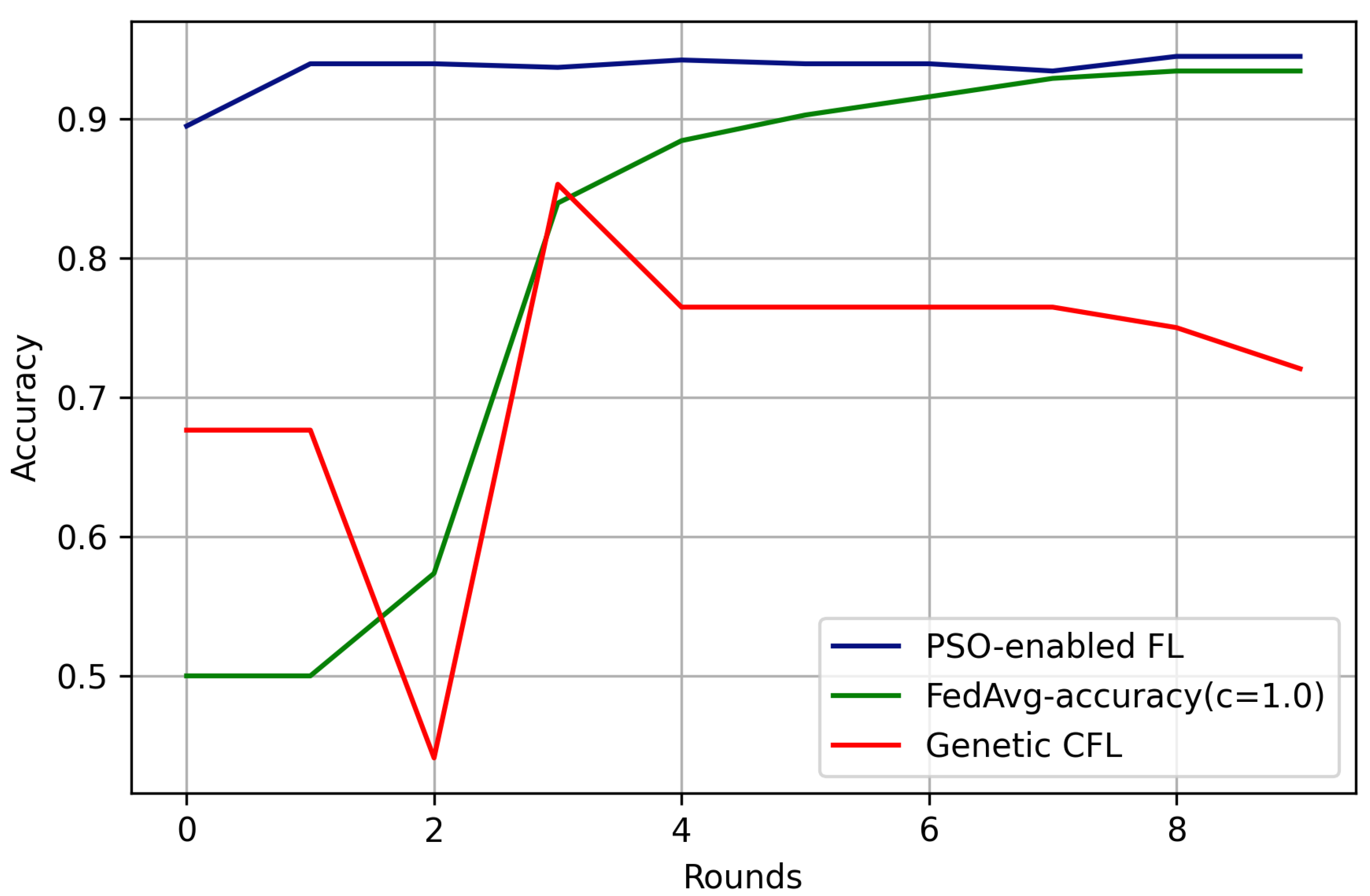
| Ref. No | Methods | Advantages | Research Challenges |
|---|---|---|---|
| [35] | Federated matched averaging (FedMA) algorithm | FedMA builds the shared global model layer by layer based on the feature extraction signatures of hidden elements | No Privacy protection measures, data bias |
| [31] | Federated Optimization | Mobile Devices are built as nodes for computation | Lack of dataset, no theoretical justification |
| [41] | FL and Red Fox Optimization | The worker and the server operation is combined as a small operation | Parameters are chosen randomly and the execution time is extended |
| [57] | Aqua-Fel PSO | Detects the pollution in water and also estimates the quality of the water | Multiple water quality parameter models are not estimated |
| [58] | PSO + FL = PAASO | The function that is needed to be optimized by agents can be understood | Does not show good performance in heterogeneous environment |
| [59] | PSO and FL | PSO optimizes the eight of the clients that are sent to the aggregation | FL models are not stable and thus can be improvised further |
| [60] | FPSO-FS algorithm | PSO can search for optimal private subset and FL solves the privacy issues in multi-participants involvement | Execution time is very high |
| This Paper | PSO and FL | This unified framework will help in early detection of forest fires. | Does not analyze other nature-inspired algorithms |
| Symbols | Description |
|---|---|
| N | number of customers |
| Learning rate | |
| weights of model |
| Dataset | Training | Testing | Total |
|---|---|---|---|
| Fire | 760 | 190 | 950 |
| No-fire | 760 | 190 | 950 |
| Total | 1520 | 380 | 1900 |
| Layer | Shape |
|---|---|
| Layer 1 | Conv2D(32, 3, 3) ReLU, MaxPool2D(2, 2) |
| Layer 2 | Conv2D(64, 3, 3) ReLU, MaxPool2D(2, 2) |
| Layer 3 | Conv2D(128, 3, 3) ReLU, MaxPool2D(2, 2) |
| Layer 4 | Dense(512) ReLU |
| Layer 5 | Dense(2) Sigmoid |
| Work | Accuracy | Dataset | Method |
|---|---|---|---|
| Proposed work | 94.47% | Forest-Fire Dataset | FL and PSO |
| Sousa et al. [62] | 93.6% | open-source dataset | Transfer Learning |
| Govil et al. [63] | 91% | Cal Fire Dataset | Deep Learning |
| Sun et al. [64] | 94.1% | Random Dataset | Multi-convolution kernels |
| Tang et al. [65] | 92% | Random Dataset | Deep Learning |
| Lin, Chen, Li, Yu, Jia, Zhang and Liang [66] | 54% | FengYun-2G S-VISSR data | Contextual based |
Disclaimer/Publisher’s Note: The statements, opinions and data contained in all publications are solely those of the individual author(s) and contributor(s) and not of MDPI and/or the editor(s). MDPI and/or the editor(s) disclaim responsibility for any injury to people or property resulting from any ideas, methods, instructions or products referred to in the content. |
© 2023 by the authors. Licensee MDPI, Basel, Switzerland. This article is an open access article distributed under the terms and conditions of the Creative Commons Attribution (CC BY) license (https://creativecommons.org/licenses/by/4.0/).
Share and Cite
Supriya, Y.; Gadekallu, T.R. Particle Swarm-Based Federated Learning Approach for Early Detection of Forest Fires. Sustainability 2023, 15, 964. https://doi.org/10.3390/su15020964
Supriya Y, Gadekallu TR. Particle Swarm-Based Federated Learning Approach for Early Detection of Forest Fires. Sustainability. 2023; 15(2):964. https://doi.org/10.3390/su15020964
Chicago/Turabian StyleSupriya, Y., and Thippa Reddy Gadekallu. 2023. "Particle Swarm-Based Federated Learning Approach for Early Detection of Forest Fires" Sustainability 15, no. 2: 964. https://doi.org/10.3390/su15020964
APA StyleSupriya, Y., & Gadekallu, T. R. (2023). Particle Swarm-Based Federated Learning Approach for Early Detection of Forest Fires. Sustainability, 15(2), 964. https://doi.org/10.3390/su15020964







